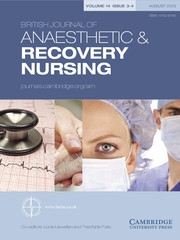Article contents
Older People with Dementia in the Perioperative Care Environment: Key Issues for Perioperative Nursing
Published online by Cambridge University Press: 01 August 2011
Abstract
Ageing is a normal process and much diversity exists in the physical, psychosocial and spiritual needs of older individuals. While many older people remain independent active and well, there is a rise in the prevalence of dementia. Developments in surgical techniques and improved patient outcomes have resulted in larger numbers of older people now undergoing surgery. However, age-related risks and complexities persist including the existence of cognitive impairment and dementia. Perioperative care of older patients with dementia provides additional challenges for nurses and other healthcare professionals. This paper discusses the unique care needs of older people with dementia and the role of perioperative nurses in meeting these needs.
- Type
- Education
- Information
- British Journal of Anaesthetic & Recovery Nursing , Volume 12 , Issue 3-4 , August 2011 , pp. 45 - 49
- Copyright
- Copyright © British Association of Anaesthetic and Recovery Nursing 2012
References
- 1
- Cited by


